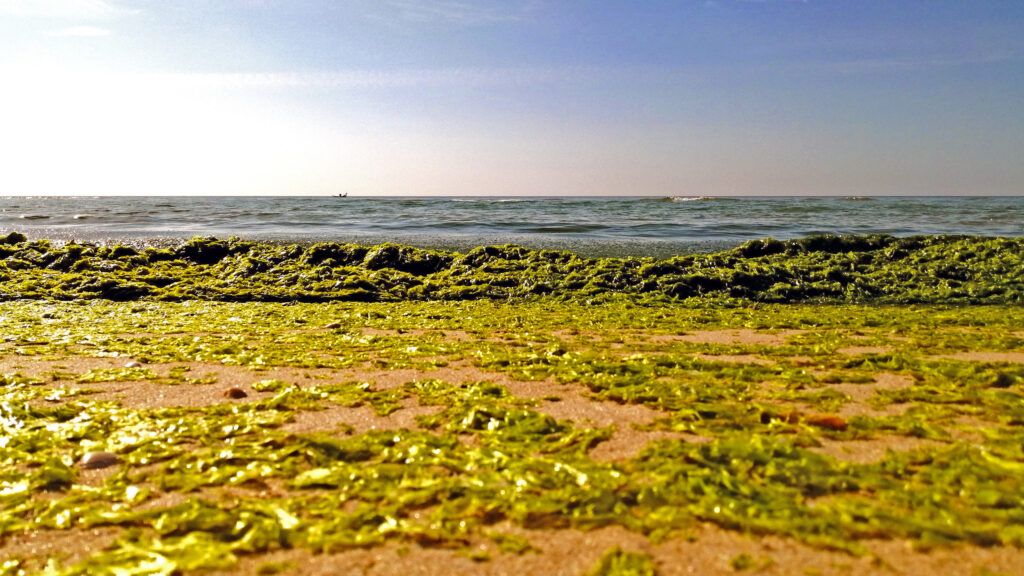A platform, in charge of researchers from the Center for Marine Sciences (CCMAR) and the University of Algarve (UAlg), will continue, for the third consecutive year, to monitor “Algas on the Beach”.
The researchers call on citizens to collaborate in identifying large accumulations of algae in the sea or on the beaches of the Portuguese coast, including the Azores and Madeira.
Although more data are needed to validate the observations, the results obtained so far have already made it possible to better understand these phenomena and to investigate potential uses and ways of valuing these algae.
«Since its launch, at the end of July 2021, we have had good adherence by citizens and beach professionals with the submission of 167 registrations, in 2021, and 161 in 2022», says Dina Simes, professor at the University do Algarve and researcher at CCMAR.
The analyzes of these records, carried out by marine biologist Rui Santos, a researcher at CCMAR, made it possible to identify three distinct zones of macroalgae accumulations on the coast of the Algarve.
In the rockier area of Barlavento, in 2021, and with greater incidence in 2022, large accumulations of Rugulopteryx okamurae, a species of brown seaweed native to the seas of Japan and Korea. In the most central area of the Algarve, between Albufeira and Faro, there were large accumulations of red algae asparagopsis armata originating in Australian waters.
These accumulations were more pronounced in 2021 than in 2022. Several records were received of large accumulations of a species native to our coast in the Algarve, the Ulva sp mainly in 2021 with a decrease in 2022.
“Although nutrients are generally the main cause of excessive algae growth, the results obtained do not show this correlation”, according to Dina Simes.
According to the researchers, "although nutrients are generally the main cause of excessive algae growth, the results obtained so far do not show a significant correlation between the concentration of nutrients in the water and the occurrence of these accumulations".
On the other hand, «a significant relationship was observed with other environmental parameters, namely temperature and wind».
The accumulations of species asparagopsis armata, on the beaches of Quarteira-Faro, and Ulva spp., in the Sotavento, are related to the north (N) and northwest (NW) winds, while the accumulations of Rugulopteryx okamurae, on the Barlavento beaches, are more related to a higher water temperature.
However, the researchers point out, “data from more years will be needed to validate these observations”.
Regarding the impact on biodiversity and on the structure of communities, the citizen science program “Algas na Praia” did not allow assessing the impact of large developments of algae species, but it did identify that there are three species that appear in large quantities on the beaches of the whole Algarve. Two are invasive alien species, asparagopsis armata e Rugulopteryx okamurae.
Specifically, the species R. okamurae has been plaguing the southern coast of Spain for several years, showing an explosive invasive character, causing a reduction in biodiversity in native communities and negative impacts on local fisheries. This same highly invasive behavior, with a great impact on the biodiversity of native species, was also studied on the Algarve coast, within the scope of a CCMAR project.
So far, explain the researchers, "the results suggest that the increase in sea temperature can favor the great development and accumulation of the exotic brown algae Rugulopteryx okamurae, while wind from the north quadrant may be a key factor for the development of native species of green algae Ulva spp. and the exotic red seaweed asparagopsis armata».
However, «it will be necessary to investigate in greater detail the importance of these and other factors, such as currents, for the development of an early detection system that can predict the large accumulations of algae on the beaches, so that mitigation strategies can be implemented and adaptation, such as the harvesting of biomass and its economic value'.
“Research into potential uses and ways of valuing these algae could turn this problem into an opportunity likely to generate wealth”, says Dina Simes, coordinator of the NutriSafe project.
The researcher also assures that «the study of extracts and purified compounds, obtained from the biomass of these invasive algae, has already allowed the identification of species, containing a high content of anti-inflammatory and antioxidant compounds, including vitamins such as K, which have a preventive in the development of chronic inflammatory diseases that affect the older population, such as cardiovascular disease, chronic lung disease and osteoarthritis».
Through NutriSafe «extracts and purified compounds from these biomasses have already been obtained, which are currently being tested in pre-clinical models with the objective of making new food supplements based on compounds of marine origin available on the market, which are effective and more accessible to general population”.
The “Algas na Praia” platform will continue, with the main objectives not only to monitor and identify phenomena of large accumulations of algae in the water and on the beaches, but also to promote studies on the valuation of this biomass through high value products for the pharmaceutical, nutraceutical or cosmetic industry, as well as for other types of industry, such as agriculture, livestock and the environment, which is why the continuation of the platform and the participation of citizens are essential for the success of this project.



















Comments